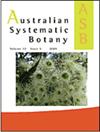Sequence capture data support the taxonomy of Pogonolepis (Asteraceae: Gnaphalieae) and show unexpected genetic structure
IF 1.6
3区 生物学
Q4 EVOLUTIONARY BIOLOGY
引用次数: 2
Abstract
ABSTRACT Variation in breeding systems between species of the same taxonomic group complicates the consistent application of species concepts, and perhaps even the logically consistent circumscription of species. Several genera of arid-zone ephemerals in the Angianthus clade (Asteraceae: Gnaphalieae: Gnaphaliinae) contain both outcrossing and non-outcrossing species. The latter are recognised by producing an order of magnitude fewer pollen grains per anther and an often reduced number of corolla lobes, and they are frequently more widespread than are the former. In its current taxonomy, the genus Pogonolepis comprises an otherwise morphologically indistinguishable pair of one outcrossing and one non-outcrossing species. I generated sequence capture data to test the genetic segregation of P. stricta and P. muelleriana and the utility of sequence capture data for species circumscription and diagnostics. Phylogenetic analysis showed the two species to form two specimen clades, supporting the current taxonomy. Contrary to expectations, non-outcrossing P. muelleriana exhibited lower gene concordance, in line with values expected from recombination, as well as higher heterozygosity than its outcrossing sister species. More research on the breeding system and population structure of the two species may be required to explain these results.序列捕获数据支持Pogonolepis(菊科:Gnaphaleae)的分类学,并显示出意想不到的遗传结构
在同一分类类群的物种之间,育种系统的差异使物种概念的一致性应用变得复杂,甚至可能使物种的逻辑界限变得一致。菊科:花蕨科:花蕨科:花蕨科)干旱区短生植物中有几个属既有异交种又有非异交种。后者的特征是每一朵花药产生的花粉粒少一个数量级,花冠裂片的数量也经常减少,而且它们通常比前者分布更广。在其目前的分类中,Pogonolepis属包括形态学上难以区分的一对,一个异交和一个非异交物种。生成了序列捕获数据,以测试P. stricta和P. muelleriana的遗传分离,并利用序列捕获数据进行物种界定和诊断。系统发育分析表明,这两个物种形成了两个标本枝,支持了目前的分类。与预期相反,非异交的穆勒伪种表现出较低的基因一致性,符合重组的预期值,并且比异交的姐妹种具有更高的杂合性。可能需要对这两个物种的繁殖系统和种群结构进行更多的研究来解释这些结果。
本文章由计算机程序翻译,如有差异,请以英文原文为准。
求助全文
约1分钟内获得全文
求助全文
来源期刊

Australian Systematic Botany
生物-进化生物学
CiteScore
3.10
自引率
12.50%
发文量
12
审稿时长
>12 weeks
期刊介绍:
Australian Systematic Botany is an international journal devoted to the systematics, taxonomy, and related aspects of biogeography and evolution of all algae, fungi and plants, including fossils. Descriptive taxonomic papers should normally constitute a comprehensive treatment of a group. Short papers on individual species and nomenclatural papers must contain significant new information of broader interest to be considered. The prestigious L.A.S. Johnson Review Series is published. Other review articles will also be considered. All papers are peer reviewed.
Australian Systematic Botany is published with the endorsement of the Commonwealth Scientific and Industrial Research Organisation (CSIRO) and the Australian Academy of Science.
 求助内容:
求助内容: 应助结果提醒方式:
应助结果提醒方式:


